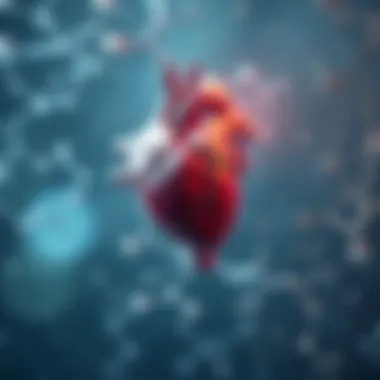Advancements in Diuretic Therapy for Heart Failure


Overview of Research Topic
The management of heart failure has long been a tricky endeavor for healthcare professionals. Heart failure patients typically experience fluid overload, which can lead to devastating complications. Diuretics have long been the go-to treatment for managing this condition, helping patients maintain optimal fluid balance. In recent years, the landscape of diuretic therapy has shifted significantly, sparking keen interest and extensive research.
Brief Background and Context
Historically, conventional diuretics like furosemide have been utilized primarily to reduce symptoms related to heart failure. Nevertheless, as our understanding of the disease has evolved, so too have treatment options. Newer classifications of diuretics have emerged, aiming to offer improved efficacy and safety profiles than their predecessors. The advancements encapsulate a myriad of medications specifically crafted to target various pathways in fluid retention and electrolyte management.
Importance in Current Scientific Landscape
The significance of these advancements cannot be overstated. Robust research is now delineating the efficacy of novel diuretics in a context where every detail matters for patient outcomes. Beyond symptom relief, improvements in diuretic strategies may pave the way for enhanced long-term management of heart failure, resulting in better quality of life and even reduced mortality rates. This nuanced understanding reflects a vital aspect of modern cardiology and underscores the commitment to tailoring therapy based on canine patient needs.
Methodology
The depth of research into these new diuretic therapies can be likened to peeling an onion—layer by layer revealing insightful evidence. By employing comprehensive methodologies, researchers hone in on diuretic efficacy and safety with a critical eye.
Research Design and Approach
A variety of study designs have emerged, from randomized controlled trials to observational studies. These trials address both short-term and long-term effects of diuretic therapies, examining not just clinical outcomes, but quality of life for patients as well. The inclusion of diverse demographic populations adds to the robustness of these findings, allowing for a more comprehensive outlook on therapy effectiveness.
Data Collection Techniques
Innovative data collection methods, including electronic health records analysis and patient-reported outcome measures, have transformed how researchers gauge therapy success. The incorporation of patient feedback provides a holistic view of diuretic impact, shedding light on areas that may require adjustments or enhancements.
In summary, the advancements in diuretic therapy for heart failure are not only a topic of clinical interest but represent a critical evolution in management strategies aimed at improving patient quality of life. As research proliferates, the narrative around diuretics continues to deepen, leading to a more informed practice in the realm of cardiology.
"Progress in heart failure management, particularly through diuretic advancements, symbolizes a critical intersection of science and patient care."
Understanding Heart Failure
Heart failure is more than just a medical term; it represents a syndrome that affects millions worldwide, reshaping lives and unlocking a complex interplay of body systems. Understanding heart failure is crucial as it lays the groundwork for effective management strategies, including the application of diuretics. Here, we will delve into the intricacies of heart failure, defining its various forms, unraveling the underlying physiological changes, and examining its prevalence and impact on society.
Definitions and Types
Heart failure can be classified into several types. The primary distinction lies between systolic and diastolic heart failure. In systolic heart failure, the heart struggles to contract effectively, leading to inadequate blood pumped to the body. On the other hand, diastolic heart failure sees the heart's chambers becoming stiff and unable to fill properly, despite normal contractions. This condition is often referred to as heart failure with preserved ejection fraction (HFpEF). Each type has its own set of characteristics and treatment strategies, demanding a nuanced approach from healthcare providers.
Moreover, we can further categorize heart failure based on its onset—acute or chronic. Acute heart failure arises suddenly and requires immediate medical intervention, while chronic heart failure develops gradually, often over years, necessitating long-term management. Understanding these definitions and types is pivotal for tailoring treatments effectively.
Pathophysiology of Heart Failure
The pathophysiology underlying heart failure is multifaceted. At its core is the heart's diminished capacity to pump blood efficiently, which can be a consequence of various factors, including coronary artery disease, hypertension, and valve disorders. As the heart struggles to maintain adequate circulation, compensatory mechanisms come into play. The neurohormonal system initiates responses like the release of catecholamines and activation of the renin-angiotensin-aldosterone system, creating a vicious cycle that often worsens the condition.
What's key here is recognizing that fluid retention often complicates heart failure. The body's attempts to preserve blood flow can lead to congestion, manifesting in symptoms such as edema and shortness of breath. Identifying these mechanisms not only helps in understanding the patient's experience but also in designing effective therapeutic interventions, particularly in pharmacotherapy involving diuretics, which alleviate fluid overload.
Epidemiology and Disease Burden
The epidemiology of heart failure reveals its staggering burden on public health. It affects approximately 64 million people globally, a number projected to increase due to aging populations and rising rates of obesity and diabetes. The condition is not confined to any single demographic; it doesn't discriminate by age or sex, affecting a broad spectrum of individuals.
Moreover, heart failure accounts for a significant proportion of hospital admissions, placing immense strain on healthcare systems. It is a leading cause of morbidity and mortality. In terms of economic impact, heart failure generates costs that run into billions, attributable to hospital care, long-term management, and loss of productivity.
Educating healthcare professionals and patients alike about this widespread issue is crucial for fostering early detection and intervention. As we delve deeper into the various treatments—like advancements in diuretic therapy—we begin to see how managing heart failure effectively can significantly improve patient quality of life.
“An ounce of prevention is worth a pound of cure.” - Benjamin Franklin.


This adage rings true when discussing heart failure, emphasizing the importance of organized follow-up and proactive management to stave off complications. To truly tackle heart failure's impact, we must adopt a comprehensive approach encompassing awareness, early diagnosis, and informed treatment choices.
The Role of Diuretics in Heart Failure
Diuretics hold a pivotal role in the management of heart failure, serving as essential tools to alleviate fluid overload and improve patient outcomes. This section dives into how diuretics function, the variety currently available, and the circumstances under which they are most beneficial. Given the diverse manifestations of heart failure, understanding the nuances surrounding the usage of diuretics, their mechanisms, and indications is crucial for both healthcare providers and patients.
Mechanism of Action
Diuretics, commonly referred to as water pills, primarily act by promoting the excretion of sodium and water from the body through the kidneys. The way they achieve this can vary by their class:
- Loop Diuretics: Medications like furosemide target the loop of Henle in the nephron, increasing urine output significantly. They prevent the reabsorption of sodium and chloride, leading to a considerable reduction in blood volume and, consequently, the workload on the heart.
- Thiazide Diuretics: These are generally milder than loop diuretics and work on the distal convoluted tubule. They can help manage mild fluid retention but are often used in conjunction with loop diuretics for added efficacy.
- Potassium-Sparing Diuretics: Medications such as spironolactone not only promote diuresis but also help in retaining potassium, offering a balancing effect in patients who might experience hypokalemia from other diuretic use.
By understanding the mechanisms, healthcare providers can tailor diuretic use according to the patient’s specific needs and clinical situation, ultimately leading to better management of heart failure symptoms.
Current Diuretic Options
As of now, several diuretics are employed in heart failure management, each with distinct profiles:
- Furosemide (Lasix): The most widely used loop diuretic, effective in acute and chronic heart failure stages.
- Bumetanide (Bumex): Another loop diuretic known for its potency and quicker action.
- Torsemide (Demadex): Offers a longer duration of effect compared to furosemide.
- Hydrochlorothiazide: A thiazide diuretic useful for mild hypertension and fluid retention.
- Spironolactone: A cornerstone for treating chronic heart failure, particularly in patients with preserved ejection fraction, as it acts not just as a diuretic but also blocks aldosterone.
The choice among these diuretics often hinges on factors like the patient’s kidney function, severity of heart failure, and the presence of co-morbid conditions.
Indications for Use
Diuretics are indicated in various heart failure scenarios, especially when fluid overload is detrimental. Key indications include:
- Symptomatic Relief: Patients with heart failure often experience symptoms such as dyspnea and peripheral edema due to fluid retention. Diuretics can quickly alleviate these symptoms, improving quality of life.
- Preventing Hospitalization: Effective management of fluid overload through diuretic therapy can reduce the need for hospitalization due to exacerbations.
- Adjunct Treatment: While diuretics are not cardioprotective in the traditional sense, they can be crucial when combined with other heart failure medications, addressing symptoms while other therapies target underlying causes.
"Diuretics are not just about reducing fluid; they are about enhancing life quality for patients with heart failure."
By comprehensively addressing symptom management and providing physicians with versatile options, diuretics remain invaluable in the evolving landscape of heart failure treatment.
New Diuretics: An Overview
Diuretics have long been a cornerstone in the management of heart failure, especially in cases where fluid retention becomes a pressing concern. With the continual evolution of medical science, there's an emerging focus on new diuretics that promise not only to enhance fluid management but also to improve overall patient outcomes. Understanding these advancements is crucial for clinicians and researchers alike. The development of novel diuretics can lead to improved efficacies, fewer side effects, and better patient adherence. This section will shed light on recent strides in diuretic therapy, discussing specific benefits these agents bring to the table as well as key considerations in their usage.
Overview of Recent Developments
The landscape of diuretic therapy has evolved remarkably in recent years. New classes of diuretics are emerging, aimed at addressing the limitations of traditional agents like furosemide or bumetanide. These latest options focus on optimizing kidney function while simultaneously minimizing adverse effects that often accompany older medications.
- New Mechanisms: A significant breakthrough is the introduction of diuretics that leverage various mechanisms for fluid removal, as opposed to relying solely on the standard pathways. For instance, specific agents target sodium-glucose co-transporters to promote diuresis.
- Enhanced Efficacy: Clinical trials indicate that new diuretics yield quicker onset and improved efficacy when it comes to symptom relief. Patients undergoing treatment often report a more immediate reduction in symptoms of congestion — a common distress in heart failure.
- Reduced Side Effects: One essential advancement in modern diuretics is their safety profile. Newer agents are designed to be less nephrotoxic, which is a prime concern with traditional diuretics.
These developments bear significant importance as they not only aim to tackle the fluid overload efficiently but also promise an improved quality of life for patients.
Emerging Diuretic Agents
As researchers delve deeper into the pharmacology of diuretics, several promising agents are coming to light. These new medications offer various approaches to tackle heart failure complications.
- Sodium-glucose cotransporter 2 (SGLT2) Inhibitors: Initially approved for diabetes management, these agents have shown diuretic properties that are beneficial for heart failure patients. They work by blocking the reabsorption of glucose in the kidneys, which leads to osmotic diuresis. Notably, studies highlight their potential for improving cardiorenal outcomes and cardiovascular health overall.
- Vasopressin Receptor Antagonists: Another innovative class involves antagonists that disrupt vasopressin’s effect on the kidneys. By doing so, they promote water excretion and thereby tackle fluid retention effectively without leading to significant electrolyte imbalance.
- Aldosterone Antagonists: While not entirely new, recent formulations of aldosterone antagonists have been redesigned to improve their efficacy and safety, especially in resistant heart failure cases. These agents not only help with diuresis but also have cardioprotective effects.
- Natriuretic Peptides: Certain newer therapies focus on the mechanism of natriuresis by utilizing synthetic natriuretic peptides that play a role in the body’s natural ability to regulate blood pressure and volume.
Through these advancements, new diuretic agents show a promise of enhancing heart failure management significantly. As the field progresses, it is essential for healthcare professionals to keep abreast of these developments, given their direct implications on treatment efficacy and patient outcomes.
Comparative Efficacy of New Diuretics
Understanding the comparative efficacy of new diuretics in heart failure management is pivotal. With heart failure affecting millions globally, it's imperative that treatment options are not only effective but also distinct in their benefits and potential drawbacks. New diuretics promise enhancements over traditional therapies, presenting opportunities for better patient outcomes and refined management strategies. In this section, we will delve into these advancements, particularly focusing on insights drawn from clinical trials and long-term outcomes.


Clinical Trial Insights
The landscape of diuretic therapy is shifting, shaped significantly by recent clinical trials assessing new agents. For instance, the introduction of sacubitril/valsartan has demonstrated promising efficacy in reducing hospitalization rates and mortality when combined with traditional diuretic therapies. Through rigorous trials like PARADIGM-HF, researchers have gained critical insights into how these novel agents function in synergy, improving fluid management while addressing underlying cardiac function.
Consider studies highlighting furosemide variations that examine dosing strategies and frequency of administration. Trials have shown that higher doses might lead to diminishing returns, emphasizing individualized dosing strategies based on patient-specific factors such as renal function and concurrent medications. The findings signal that the effectiveness of new diuretics is not homogeneous; rather, it requires a nuanced approach, informed by trial data.
In addition to sacubitril/valsartan, emerging agents focusing on natriuretic peptides have been explored. Trials demonstrate that these agents can lead to more potent diuresis while also affecting cardiovascular dynamics positively. The dual action not only alleviates the immediate symptoms of fluid overload but may enhance renal function, a critical concern in heart failure patients.
The insights from these trials underscore the need for clinicians to remain agile in adapting treatment protocols based on evolving evidence, fostering a tailored approach in the heart failure therapeutic landscape.
Long-Term Outcomes
The long-term outcomes of utilizing new diuretics are a crucial area of focus. Continuity of this therapy hinges on not just immediate efficacy but also sustained health improvements for patients battling heart failure. A pivotal aspect is the impact of these drugs on kidney function over extended periods. While traditional diuretics like bumetanide are effective, their long-term use can lead to electrolyte imbalances and renal impairment. New agents are being designed to mitigate these issues.
For instance, clinical reports suggest that when new diuretics are used in conjunction with monitoring strategies, they yield better renal outcomes. Patients maintain electrolyte balance more effectively, aiding in longer-term adherence to therapy and overall well-being. Longitudinal studies, therefore, become indispensable for establishing whether these new therapeutic options translate into reduced hospitalizations and improved quality of life.
Furthermore, long-term efficacy isn’t just a matter of survival; it’s about maintaining an acceptable quality of life. That involves minimizing adverse effects and assuring that patients can engage meaningfully in daily activities without debilitating symptoms. The nuanced understanding derived from long-term trials is essential in shaping treatment protocols that are not only efficacious but also patient-centered.
"Long-term outcomes from clinical trials establish the framework for optimizing heart failure management, ensuring patients not only survive but thrive."
The ongoing analysis of both clinical insights and long-term outcomes solidifies the importance of new diuretics in contemporary heart failure therapy. As research progresses, continued exploration into these newer agents will illuminate pathways for truly individualized treatment plans, steering clear of the one-size-fits-all approach that has dominated this field for far too long.
Safety Profiles of Modern Diuretics
Understanding the safety profiles of modern diuretics is paramount in the context of heart failure management. As diuretics play a critical role in alleviating fluid overload, their side effects and safety concerns also merit considerable attention. The balancing act between managing heart failure symptoms and avoiding adverse effects cannot be overstated. With heart failure patients often taking multiple medications, the interactions and cumulative effects of diuretics must be carefully considered to optimize treatment plans.
Adverse Effects and Management
Diuretics are generally well tolerated, but they come with a range of possible adverse effects. Some common ones include:
- Electrolyte Imbalances: This can lead to low potassium (hypokalemia) or sodium levels (hyponatremia), potentially causing severe complications such as arrhythmias.
- Dehydration: Excessive fluid loss might lead to dehydration, particularly in elderly patients or those with renal impairment.
- Renal Dysfunction: Some diuretics can negatively impact kidney function, necessitating frequent monitoring of renal parameters in at-risk populations.
It's crucial for healthcare providers to have robust management plans in place to address these complications. For instance, regular blood tests can help monitor electrolyte levels and kidney function, allowing for prompt interventions when necessary. Additionally, educating patients about recognizing signs of dehydration or abnormal electrolyte levels can empower them in managing their own health.
"The intricacies of managing diuretic therapy aren't just about addressing fluid overload; they also involve a fine-tuned awareness of potential side effects that can escalate quickly if left unchecked."
Risk Factors for Complications
Recognizing risk factors associated with diuretic therapy is essential to minimize complications. Some key considerations include:
- Age: Older adults are often more susceptible to side effects due to decreased physiological reserve and polypharmacy.
- Renal Health: Patients with pre-existing renal dysfunction are at heightened risk for complications from diuretic use.
- Baseline Electrolyte Levels: Patients with prior electrolyte imbalances may experience exacerbated issues when diuretics are introduced.
Furthermore, individualizing therapy based on these risk factors enhances safety and efficacy. Potential strategies could involve starting at lower doses, employing potassium-sparing diuretics, or incorporating regular follow-ups to tailor treatment accordingly.
In summary, while diuretics are vital tools in heart failure management, understanding their safety profiles helps clinicians navigate their complexities, ensuring patient outcomes are improved with minimized risks.
Patient-Centric Approaches
In the realm of heart failure management, taking into consideration the patient's unique needs and circumstances has become increasingly vital. This approach, often termed patient-centric, goes beyond one-size-fits-all treatments. Instead, it seeks to tailor diuretic therapies to the individual, understanding that the same treatment may not work uniformly across different patients. This recognition can significantly enhance patient outcomes, improving both adherence to medication regimens and engagement in the care process.
Personalized Treatment Plans
Creating personalized treatment plans is a cornerstone of patient-centered care in heart failure management. Every patient presents a distinct set of challenges, preferences, and comorbidities that can influence how they respond to diuretics. For example, a patient with diabetes might require different medication adjustments compared to one with renal issues.
Healthcare providers are encouraged to take a holistic view—considering not only the clinical data but also lifestyle factors and patient-reported outcomes. This could include:


- Monitoring the patient's fluid status: Assessing how well a patient is handling fluid intake and the effectiveness of diuretics over time.
- Adjusting dosages as needed: There may be a need to modify diuretic doses based on individual responses or side effects, such as electrolyte imbalances.
- Engaging patients in decision-making: Holding discussions that allow patients to voice their experiences and preferences can lead to better adherence and satisfaction.
By developing a treatment plan co-created with the patient, clinicians can ensure that therapeutic goals align with what matters most to the individual, thus promoting adherence and better overall health.
Interdisciplinary Collaboration
Hearts don’t function in isolation, and neither should treatment strategies. Effective management of heart failure through diuretics often requires a collaborative approach involving various healthcare professionals. Interdisciplinary collaboration brings together cardiologists, pharmacists, dietitians, and nurse practitioners, all focusing on the same goal: optimizing patient care.
The merits of such collaboration include:
- Comprehensive care strategies: Each professional contributes their expertise, which enriches the patient’s overall treatment. For instance, a dietitian can educate on sodium restriction while the physician manages medication regimens.
- Streamlined communication: A team approach can facilitate better communication about patient progress and any barriers faced by the patient, allowing for timely interventions.
- Enhanced patient education: When patients are educated from multiple perspectives, they can better understand their condition and the rationale behind their treatment. This could demystify the use of diuretics and how they improve symptoms while reducing fluid overload.
Successful programs have shown that when healthcare teams operate in harmony, it leads to improved clinical outcomes and patient satisfaction. As walls between specialties continue to break down, the patient is central in this amplified care model, reinforcing that effective diuretic therapy in heart failure management is truly a team effort.
“In healthcare, as in life, collaboration is the key that unlocks innovation and improves outcomes.”
Future Directions in Diuretic Research
The realm of diuretic therapy is constantly evolving, especially in the context of heart failure management. This section seeks to illuminate the importance and implications of future directions in diuretic research. As the understanding of heart failure deepens, researchers are exploring innovative approaches that may reshape treatment modalities.
Future research aims to tackle several key elements and benefits associated with diuretic therapy, including:
- The development of novel drug formulations that enhance efficiency and minimize side effects.
- Identifying patient-specific factors that influence diuretic response, ultimately leading to more personalized treatment strategies.
- The integration of advanced delivery systems to optimize the pharmacokinetics of existing diuretics.
Innovative Delivery Methods
In recent years, the spotlight has shone brightly on innovative delivery methods in diuretic therapy. These approaches are designed to enhance patient experience and improve medication adherence, which significantly affects patient outcomes. Historically, most diuretics are administered orally; however, researchers are investigating alternative methods.
For instance, transdermal patches have emerged as a promising delivery system. These patches allow for controlled release of diuretics over a certain period, thus maintaining steady serum levels and reducing the need for multiple daily doses. The convenience of a patch might lead to better adherence, particularly in patients who struggle with complex regimens.
"Innovative delivery methods hold the potential to unravel the complexities of diuretic therapy, providing new avenues for patient management and care."
On the horizon are also intravenous formulations infused with targeted-release technologies that provide rapid fluid management, which could be a game changer in acute settings. Such developments address the often-volatile nature of heart failure where fluid balance is critical.
Potential for Combination Therapies
Looking forward, combination therapies represent a pivotal area for diuretic research. The traditional approach has primarily focused on single-agent therapies. However, there is an increasing recognition of the benefits that can be derived from using a multifaceted approach.
Combining different classes of diuretics may enhance diuretic efficacy while simultaneously reducing the doses of each drug, potentially minimizing side effects. For example, a combination of thiazide and loop diuretics could be explored for synergistic effects, particularly in patients who are refractory to standard treatments.
Moreover, pairing diuretics with non-diuretic agents that target underlying mechanisms of heart failure is also gaining traction. Agents like ACE inhibitors or beta-blockers, when used alongside diuretics, may not only enhance fluid management but also contribute to cardiovascular stability, thereby improving overall patient outcomes.
The future of diuretic research is laden with potential, and as researchers delve deeper into innovative delivery methods and combination therapies, it could result in superior management strategies for heart failure patients. The insights gleaned from ongoing studies will undoubtedly shape the landscape of heart failure treatment in the years to come.
The End
Recapitulating Key Findings
The exploration of diuretics has journeyed far beyond merely addressing symptoms. Here are key takeaways:
- Mechanism of Action: New diuretics are designed not just to promote diuresis but to optimize electrolyte balance and minimize adverse effects. Agents like torsemide demonstrate distinct pharmacokinetic properties compared to previous standard therapies, offering improved efficacy and reduced incidence of side effects.
- Clinical Efficacy: Emerging clinical trials highlight the advantages of newer agents, illustrated by significant improvements in patient outcomes when innovative therapies are used. For instance, those using novel molecules have shown robust responses regarding reductions in hospital readmissions due to heart failure exacerbations.
- Patient-Centric Approaches: Future discussions must consider the individual profiles of patients—what works for one might not be suitable for another. Personalization of care empowers practitioners to utilize diuretics more effectively while drawing from a growing body of evidence supporting their decisions.
"Diuretics are not merely a band-aid solution for heart failure; rather, they are becoming sophisticated tools in managing a complex condition."
Implications for Clinical Practice
The implications for clinical practice are pivotal, encompassing various aspects crucial for heart failure management:
- Adopting New Agents: Practitioners are encouraged to integrate new diuretic options into their protocols, weighing their specific pros and cons. This involves training and education, ensuring that all members of the healthcare team are well-informed about recent advancements and their potential applications.
- Long-Term Management Considerations: The insights gained through long-term studies not only guide medication choices but also preference for combination therapies that might optimize outcomes further. Recognizing when and how to escalate therapy is an essential skill for clinicians.
- Patient Education: In an age where patients are becoming more involved in their own healthcare decisions, educating them about the options available, including newer diuretics, can lead to improved adherence and outcomes. Informative and clear communication fosters trust and engagement.
The conclusion thus serves not merely as a summary but as a launchpad for continued improvement in heart failure care through innovative diuretic therapies. Our collective future rests on understanding and adapting to these advancements, ensuring that every patient receives the gold standard of management tailored to their unique needs.



